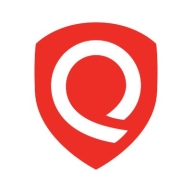

Find out in this report how the two Patch Management solutions compare in terms of features, pricing, service and support, easy of deployment, and ROI.
With Qualys, we can save around 70 percent of time and between 30 to 40 percent of money.
We have a 50 percent return on investment due to reduced operational complexity and increased efficiency in patching and detection.
We have achieved significant time savings of 90 percent, primarily due to comprehensive oversight and visibility of security issues.
The support team is experienced and responsive.
The support team is responsive and provides detailed information.
Whenever we raise a request and mention the priority of the ticket, they respond immediately via email or call.
It needs improvement in response time and addressing feature requests promptly.
The technical support of Tenable Vulnerability Management is available 24/7, and whenever we require support, we can get it within five minutes.
I would evaluate Tenable Vulnerability Management's customer service and technical support as average.
It scales efficiently across different machines globally, ensuring patches are deployed smoothly.
Qualys Patch Management is a globally scalable product, easily handling increasing workloads and users.
If a client has purchased licensing for ten thousand assets and exceeds that, Qualys continues to scan those additional assets, which ensures the client's coverage.
They can seamlessly scale the number of endpoints from 100 to 1,000,000 in a day.
Tenable Vulnerability Management is highly scalable.
I would rate the stability of Qualys Patch Management nine point five out of ten.
The stability of Qualys Patch Management is impeccable.
Overall, it is reliable.
I have faced no stability issues with Tenable.
The stability is commendable, and I would rate Tenable ten out of ten.
The stability of Tenable Vulnerability Management is highly reliable.
There is a limitation where Qualys may not always offer solutions for remediation, particularly for end-of-life or end-of-service applications.
It would be better if Qualys Patch Management identifies whether the process has failed at the first instance and provides a retry button or retry mechanism, allowing retries for failed patches.
For critical options, they could make them red, green for medium, and blue for less significant options.
They should also accelerate the process of implementing new features upon request.
I would suggest HP WebInspect as a better option than Tenable.io.
Tenable Vulnerability Management is not very effective for real-time risk prioritization for our organization's security strategy.
We get many more features at the same price as other solutions such as Microsoft SCCM.
However, it can be a bit expensive sometimes, and I think clients can be shocked when they see the price.
The pricing is reasonable and less expensive than the previous tool.
Tenable charges around $40 per device, while Rapid7 costs $10 to $15 per device.
We leverage this functionality to deploy scripts that adjust registry values, effectively patching vulnerabilities and enhancing the security of our machines.
We have been able to apply workarounds for zero-day vulnerabilities efficiently.
It provides insight into the organization's security posture and keeps databases updated with new CVEs.
Tenable enables vulnerability management through potential AI integration that consolidates efforts and resolves multiple vulnerabilities simultaneously.
The main benefit of integration with Tenable Vulnerability Management is that there will be no lack of missing vulnerabilities when it comes to the patching environment.
The best features of Tenable Vulnerability Management are flexibility, breadth and scope, and the fact that their current vulnerabilities come out, and they have tests for them within a day or two.
| Product | Market Share (%) |
|---|---|
| Qualys Patch Management | 3.6% |
| Tenable Vulnerability Management | 1.5% |
| Other | 94.9% |

| Company Size | Count |
|---|---|
| Small Business | 12 |
| Midsize Enterprise | 5 |
| Large Enterprise | 23 |
| Company Size | Count |
|---|---|
| Small Business | 20 |
| Midsize Enterprise | 2 |
| Large Enterprise | 21 |
Qualys Patch Management optimizes patching and vulnerability remediation through automation and intelligence insights, accelerating the process by 43% and improving patch rates by 90%. Its integration with CMDB and ITSM tools speeds up ticket closures by 60%, effectively reducing the attack surface while freeing IT and security resources. This cloud-based solution bridges the IT-security gap, making it essential for cybersecurity.
Managed in the cloud and powered by Tenable Nessus, Tenable Vulnerability Management (formerly Tenable.io) provides the industry's most comprehensive vulnerability coverage with real-time continuous assessment of your organization. Built-in prioritization, threat intelligence and real-time insight help you understand your exposures and proactively prioritize remediations.
We monitor all Patch Management reviews to prevent fraudulent reviews and keep review quality high. We do not post reviews by company employees or direct competitors. We validate each review for authenticity via cross-reference with LinkedIn, and personal follow-up with the reviewer when necessary.